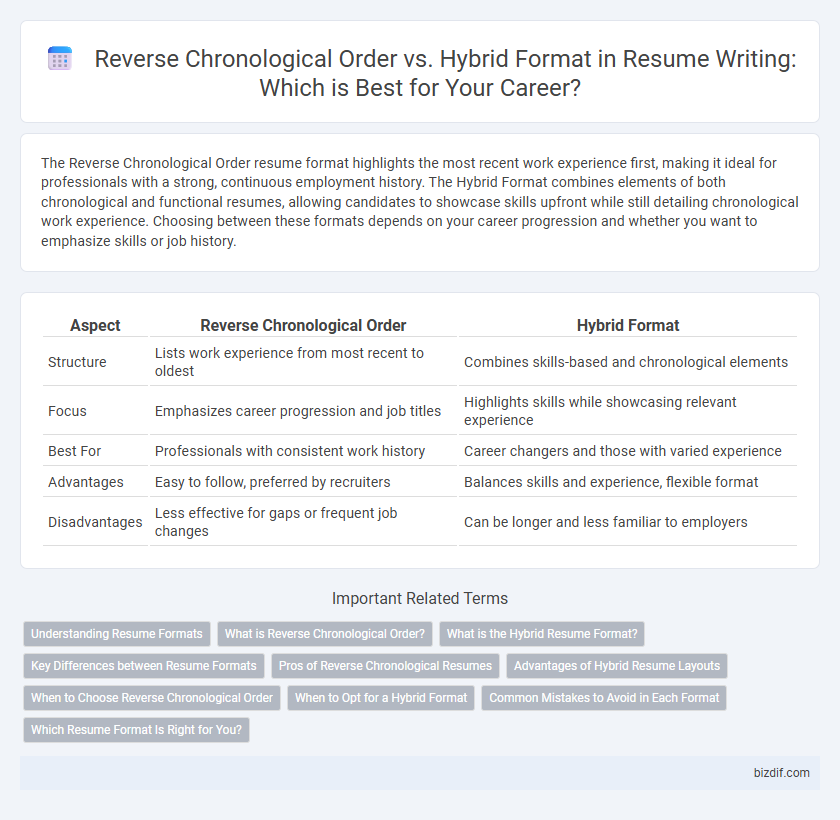The Reverse Chronological Order resume format highlights the most recent work experience first, making it ideal for professionals with a strong, continuous employment history. The Hybrid Format combines elements of both chronological and functional resumes, allowing candidates to showcase skills upfront while still detailing chronological work experience. Choosing between these formats depends on your career progression and whether you want to emphasize skills or job history.
Table of Comparison
| Aspect | Reverse Chronological Order | Hybrid Format |
|---|---|---|
| Structure | Lists work experience from most recent to oldest | Combines skills-based and chronological elements |
| Focus | Emphasizes career progression and job titles | Highlights skills while showcasing relevant experience |
| Best For | Professionals with consistent work history | Career changers and those with varied experience |
| Advantages | Easy to follow, preferred by recruiters | Balances skills and experience, flexible format |
| Disadvantages | Less effective for gaps or frequent job changes | Can be longer and less familiar to employers |
Understanding Resume Formats
Reverse chronological order prioritizes recent work experience, showcasing a clear career progression ideal for candidates with consistent employment history. Hybrid format combines chronological and functional elements by highlighting relevant skills first, followed by a detailed work timeline, making it suitable for career changers or those with varied experiences. Understanding these resume formats helps tailor content to industry expectations, improving applicant tracking system (ATS) compatibility and recruiter engagement.
What is Reverse Chronological Order?
Reverse chronological order is a resume format that lists work experience starting with the most recent position and moving backward in time. This format highlights career progression and is preferred by employers for its clear demonstration of professional growth and consistency. It is particularly effective for candidates with a solid, continuous work history in the same field.
What is the Hybrid Resume Format?
The hybrid resume format combines the strengths of the reverse chronological and functional formats by highlighting both skills and work experience in a balanced layout. It typically begins with a summary of key competencies or achievements, followed by a detailed reverse chronological work history, making it ideal for candidates with diverse backgrounds or career changes. This format enhances keyword optimization and improves ATS compatibility while providing a comprehensive view of qualifications.
Key Differences between Resume Formats
Reverse chronological order highlights a candidate's work history by listing experiences from the most recent to the oldest, emphasizing career progression and stability. The hybrid format combines chronological and functional elements, showcasing relevant skills and achievements alongside a detailed employment timeline. Key differences include reverse chronological's focus on employment dates and hybrid's balance between skills and experience, making the choice dependent on career goals and background.
Pros of Reverse Chronological Resumes
Reverse chronological resumes highlight a candidate's most recent and relevant work experience, making it easier for employers to track career progression and assess qualifications. This format is widely recognized and preferred by recruiters for its clear and straightforward structure, enhancing readability and impact. It effectively showcases consistency and reliability in employment history, which can strengthen a candidate's credibility.
Advantages of Hybrid Resume Layouts
Hybrid resume layouts combine the strengths of reverse chronological and functional formats, showcasing both work experience and relevant skills effectively. This structure improves visibility for recruiters by highlighting achievements and competencies upfront while maintaining a clear employment timeline. Job seekers benefit from increased flexibility in tailoring their resumes to specific roles, enhancing their chances of passing applicant tracking systems (ATS).
When to Choose Reverse Chronological Order
Reverse chronological order is ideal for candidates with a strong, continuous employment history who want to highlight career progression and recent achievements to recruiters. This format emphasizes experience by listing jobs starting with the most recent, facilitating easy assessment of professional growth and relevant skills. It is especially effective in traditional industries and for those seeking roles closely aligned with their previous job titles and responsibilities.
When to Opt for a Hybrid Format
Choose a hybrid resume format when you need to highlight both skills and work experience equally, such as during a career change or when re-entering the workforce. This format combines the reverse chronological order of job history with a skills-based section, allowing candidates to showcase relevant competencies while maintaining a clear timeline. Employers benefit from seeing transferable skills upfront alongside detailed job experience, helping candidates stand out in competitive job markets.
Common Mistakes to Avoid in Each Format
Using reverse chronological order, avoid listing irrelevant or outdated jobs that dilute your key achievements and refrain from gaps without explanation, which can raise concerns for employers. In the hybrid format, be cautious not to overcrowd the skills section, which can overwhelm recruiters, and ensure that detailed job descriptions do not become repetitive, compromising clarity. Both formats require consistent formatting and clear dates to maintain professionalism and improve ATS compatibility.
Which Resume Format Is Right for You?
Reverse Chronological Order resumes highlight your most recent experience first, ideal for professionals with a consistent work history seeking roles in similar fields. Hybrid Format combines chronological and functional elements, emphasizing skills alongside a detailed work timeline, making it suitable for career changers or those with diverse experience. Choosing the right format depends on your work history, career goals, and the job requirements you aim to meet.
Reverse Chronological Order vs Hybrid Format Infographic

 bizdif.com
bizdif.com